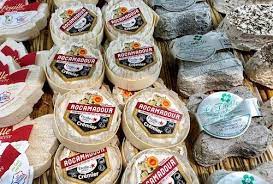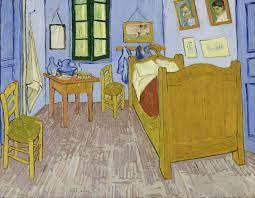A TASTE OF MONTMARTRE - LET ME INVITE YOU TO STROLL RUE LEPIC and The Musée d'Orsay.
- Valerie Swanson-Parmentier
- Aug 23, 2021
- 6 min read
Set in the 18th arrondissement, the charming hilltop Montmartre district (also known as "La Butte") is a former artists' village once inhabited by Picasso and Dalí, and home to the domed Sacré-Cœur basilica. There are sweeping views of the city from its steep, winding streets, while the iconic Moulin Rouge cabaret below draws tourists and nightclubbers. Retro-cool bars and eateries dot the edgy quartier.
Let me invite you to stroll Rue Lepic. C’est l’une des rues les plus renommées de la butte Montmartre.
Rue Lepic is one of the most famous (and one of the liveliest) streets in Montmartre. The itinerary starts in Place Blanche, near to the mythical Moulin Rouge cabaret, and finishes in Place du Tertre, the heart of Montmartre.
What I like about the Rue Lepic is that you can have a scope of authentic products from all over France.

FROMAGERIE LEPIC - 20 rue Lepic
One thing that as the Cheese Queen I need to tell you, is to go to this Fromagerie.
Never forget what Charles de Gaulle once said: "How can anyone govern a nation that has 258 varieties of cheese?" (Comment voulez-vous gouverner un pays où il existe 258 variétés de fromage ?)
You simply cannot image the array of cheese available in this compact little boutique. This is one of the most loved fromagers for the local people who call Montmartre home. You can find more than 100 types of cheeses from all over France. Each cheese is made in only one geographical area of France: for instance, if you get a Rocamadour (my favorite goat cheese, part of the family of goat cheeses called Cabecous), you have a foretaste of one of the most vertigineous village of France: Rocamadour in the South of France in the Lot. It's one of the stops along the historic pilgrim’s route of Saint-Jacques-de-Compostelle.
A visit at this Fromagerie (cheese shop) guarantees you'll eat excatly as the French do. Bear in mind the clerks do not speak English, so contact me for a crash course on how to order cheese if you need to... https://www.lblingualinstitute.com/pricing or just point at the cheese that you want. Remember: NEVER SAY I WANT in French... it's rude...
We say.. I WOULD LIKE = JE VOUDRAIS. (I know you think we are rude... but I do not speak French in L.A when I shop... people will think I have lost my marbels! Right? America is America, and France is France. Pardon my French!
CAFE DES 2 MOULINS - 15 rue Lepic
Well, do you remember the movie "Amelie" ? (the firstname of my great grand mother)
Le Fabuleux Destin d'Amélie Poulain de Jean-Pierre Jeunet. He is from the Rhone Valley area like me.
So you have to go there and order "La creme dessert Amélie". But if you can't yet, start watching the witty and creative movies made by this amazing French movie Director.
His films mix elements of fantasy, realism and science fiction either to create idealized realities or to give relevance to mundane situations. A former animator, his movies are marked by quirky, slapstick humor, alongside surrealist visuals. (César Award for Best Film, César Award for Best Director). My favorites are "Delicatessen" and "the City of Lost Children". If you love the actress of Amelie, Audrey Tautou, you will enjoy "A Very Long Engagement" or "Chanel No. 5: Train de Nuit"
MOULIN DE LA GALETTE and MOULIN LE RADET - 77 rue Lepic
We can't forget the painting of Pierre Auguste Renoir of " Le moulin de la Galette", but a lot of people forget the Debray's family history. In 1812, during the siege of Paris, the windmill was heroically defended against the Cossacks by miller Debray who was killed and its corpse nailed to the wings of the Moulin. His survinging son decided to turn the Moulin into a dance hall named "Moulin de la Galette" in honor of his family. Indeed they were making a "galette" (pancake) that was a small brown bread which was sold with a glass of milk.
In 1830 the Moulin de la Galette became a cabaret and the milk was replaced with wine produced in Montmartre. You can see the vineyards close by.
VAN GOGH and his brother Theo lived on the 3 - 54 rue Lepic
Let's go back in time... from 1886 to 1888. In early June 1886, Theo and Vincent moved out of the apartment on Rue Laval into the one at 54 Rue Lepic. The new apartment was spacious by Parisian standards.. Vincent had his own studio, a room at the back with a small window. He slept in a small room known as the cabinet. At the front of the flat were Theo's room and the living room. The walls must have eventually become covered with paintings by Vincent and others; the brothers collected works by other artists, which they bought or received in exchange for Vincent’s.
Thanks to Vincent’s sister-in-law Jo van Gogh-Bonger, who married Theo on 18 April 1889, we know how the apartment looked. It had:
“drie tamelijk groote kamers, een cabinet en een keukentje. De woonkamer was gerieflijk en gezellig met Theo’s mooie, oude kast, een gemakkelijke sofa en een groote vulkachel want de broers waren beiden even kouwelijk; daarnaast was Theo’s slaapkamer. Vincent sliep in het cabinet, en daarachter was het atelier, een gewone kamer met één, niet bizonder groot raam.” (source: Jo van Gogh Bonger, XXXVI, DL 1, 1955)
Let's now have a look at Vincent van Gogh's painting: "View from Theo's apartment", march-april 1887. You can find it at the Van Gogh Museum in Amsterdam. I have been there and it's a museum to not miss. What stroke me the most was the intensity of the colors of his painting... the pictures certainly don't translate it.
Van Gogh had become aware of Impressionism soon after arriving in Paris, but it took a while before he assimilated the knowledge into his work. This early view of his window reflects the dark colors he had been accustomed to using, subdued browns and grays for the roofs and the backs of the houses. In it Van Gogh appears to focus primarily in the color graduations of the houses and rooflines.
View of Roofs and Backs of Houses 1886 Van Gogh Museum, Amsterdam (F231)

Van Gogh's paintings are all in the Musée d'Orsay in Paris, and there is no one in the Louvre. First understand the difference between the Louvre and the Paris Orsay Museum.
The collections of the Orsay Museum were previously hidden in the Louvre. Later, the French government removed the artworks from 1840 onwards and reorganized the Orsay Art Museum (which was rebuilt in the former Expo Pavilion). From the mid-19th century to the early 20th century, Paris was the center of world art. Many top painters such as Picasso, Van Gogh, Dali, and Miro were far from their homeland to pursue their dreams in France, like Monet and Cézanne. Gauguin, Matisse, Renault... These masters are themselves French. Therefore, the Paris Orsay Gallery represents the art of the French golden age, the collection of the world's largest Impressionist and post-impressionist works, and the level is absolutely not lower than the Louvre. Many people only know that the Louvre does not know the Orsay Art Museum. It cannot be said that it is a pity.
THE MUSEE D'ORSAY - 10 MUST_SEE VAN GOGH PAINTINGS
So, let's take a stroll to the banks of the Seine, where this former train station holds the best of 19th-century art. Up on the second level, in the Gallery of Post-Impressionists, is where Vincent van Gogh reigns supreme, the most prolific artist of all times.
1. Portrait of the Artist – 1887
2. Self Portrait – 1889
3. Starry Night Over the Rhone – 1888
To express hope by a handful of stars…" 33-year old Vincent wrote to his brother Theo.

The painting was finished while van Gogh was in Arles, just before he committed himself to the asylum in Saint-Remy. In fact, he was in the asylum when he painted his other famous night work, also called Starry Night, depicting the view from his asylum room.
4. La Méridienne – 1889
5. Van Gogh's Room in Arles – 1888
I know you were not ready for this... but you can airbnb the room and it's cheap... Eryk'S Familly & Vincent are superhosts.
6. Portrait of Dr Gachet – 1890
"I would love to paint portraits, which in a hundred years will seem like ghosts to those who see them."
7. L'Arlésienne – 1888
8. Fritillaires Couronne Impériale dans un Vase de Cuivre – 1887
9. Eugène Boch – 1888
10. The Church in Auvers-sur-Oise – 1890
I could stroll with you... Je pourrais flâner avec vous à Paris for hours.... so if you need a guide when you visit Paris or French Online Lessons, contact me at: valeriefrenchteacher@gmail.com
Be safe, be well, et Carpediem!
You can follow my free French videos to practice your French here:




























